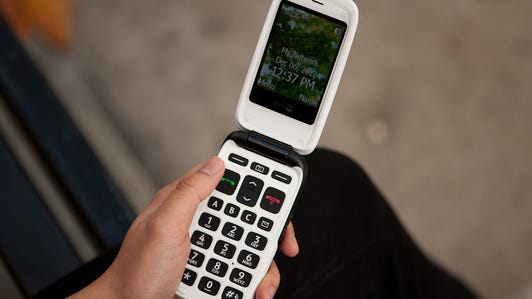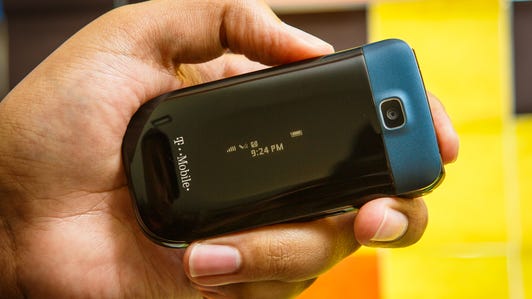Allen Calvin earned a doctorate in experimental psychology, was a consulting professor at Stanford University, and is currently the president of Palo Alto University, a post he’s been holding for 28 years. He’s learned a lot during his 84 years of living — except for how to cut and paste text on a smartphone.
“I just want to copy anything and paste it out of an e-mail,” he said with a voice that sounds like sandpaper. “This is obviously harder than it looks.”
Calvin and his wife, Dorothy, are inside a brightly lit Verizon store on Pine and Battery streets in San Francisco, attending an evening “Android: Getting Started” workshop. They’ve been married for more than 50 years, and when he jokes that Dorothy is merely 25 years old, she laughs and says she’s actually 82.
After getting suggestions from a sales rep, the couple bought two Samsung Galaxy S3s (according to Dorothy, they bought the same phone “so at least one of us has a fighting chance to figure it out”), but became increasingly frustrated with how to use it.
He wants to know how to use his handset as a hot spot. She is having trouble putting multiple numbers under one contact. Neither the online video tutorial nor the Galaxy S3’s 200-page manual proved helpful.
“I’ve been in IT for 40 years,” said Dorothy. But the phone, “is not intuitive and I can’t understand much of what’s on here.”
The Calvins aren’t alone. According to a 2012 Pew Research study, 13 percent of Americans ages 65 and over own a smartphone, a 2 percent increase from last year. Whether the majority of them can use the devices with ease, however, is another question.


Lynn La/CNET
All in the design
Phone manufacturers that specialize in the senior demographic have been trying to figure out how to make their handsets as user-friendly as possible.
At the CTIA mobile conference this year, Doro unveiled its PhoneEasy740, an unreleased smartphone created specifically for seniors. Though it has a touch screen, a data connection, and an app store, the handset also has a generously sized rubber number pad, an emergency call button, and a camera that doubles as a magnifying glass.
“Basically we were thinking: how can we take the technology and connectivity of the smartphone and bring that in with seniors?” said Thomas Bergdahl, Doro’s vice president of product development.
Other than performing well and reliably, physical design is one of the most important factors in building a good senior device. And while everyone wants the end products to look modern, simplicity is still king.
A few standards Bergdahl cited: avoid sharp edges and corners, have easily interpreted shapes, and work with buttons but be strategic about where you place them.
“There is a lot of thought in the details that you don’t see,” he said. “But you feel those details when you hold the phone in your hands.”
In addition to form factor, user interface is a key element. It should be clean and easy to follow. If done well, users will hardly notice it. Executed poorly, however, and they will become frustrated and give up.


Josh Miller/CNET
“No dead ends, no logical leaps,” said David Inns, CEO of GreatCall Inc., the producer of the Jitterbug senior handset. According to him, as soon as users aren’t sure what to do next and hit “a dead end where it’s not obvious where they’re supposed to go, you’ve lost them.”
Working out the kinks
But knowing what you want to do is one thing, and figuring out how to do it is another. A lot of research and development gets poured into creating these handsets. Both companies cited getting feedback from multiple organizations, including the San Diego Center for the Blind and the Royal National Institute for Deaf People U.K.
Doro and GreatCall also hold numerous focus groups, collaborate with several retirement communities, and, of course, have their fair share of trial and error.
In one of the first iterations of the PhoneEasy740, Doro included too many icons that demanded too much attention on the start screen.
“It became too cluttered, though we thought we already reduced the number of icons to very few,” Bergdahl said.
On older Jitterbug models, the volume buttons were placed on the front of the clamshell phone. The thought process was that it’d be easier to press the volume rocker since it was where a user’s fingers would be when the phone is held against a face anyway.
“But the feedback overwhelmingly over the years was that people pretty much wanted it moved back to the side,” Inns said.
Key design points for senior cell phones
- No sharp edges or corners, keep shapes simple
- Make sure the interface is uncluttered and streamlined
- Buttons must be strategically placed and comfortable to press
- Text should be large and easy to read
A matter of philosophy
Though the two companies mentioned different tweaks, adjustments, and features added or subtracted to their products, both of them pointed out that they never mean to coddle their key audience with their handsets or how they’re marketed.
After all, these phones are still accessories to some people, said Bergdahl. “They don’t want to go about showing that they have some difficulties or impairments.”
As for Inns, everybody uses technology to help with their own priorities; seniors simply have a set of different priorities from the mass market.
“People forget that our customers are active, growing people that are interested in technology,” he said. “They want to improve their connections with family, they want to stay safe when they’re alone without somebody around to help them, and they’re interested in technology that empowers them.”
Reliable, user-friendly phones for seniors (pictures)






+4 more
Whether a smartphone or a feature phone fulfills certain priorities is up to the individual. For Allen Calvin and his wife, they’ll stick with their Galaxy S3s, even though Calvin’s “fantasy,” as he put it, to use it in place of his laptop is slowly fading. He discovered his smartphone can’t do everything he imagined, like store and open large files, and create e-mail folders.
Then, of course, there’s the learning curve.
When the Verizon workshop leader, a patient but commanding young woman named Katrina Watts, discovered that Calvin learned how to create app folders during the seminar, she complimented him and said she noticed that he figured it out.
“No, I’m figuring it out,” quipped Calvin. “Figured and figuring is not quite the same.”



